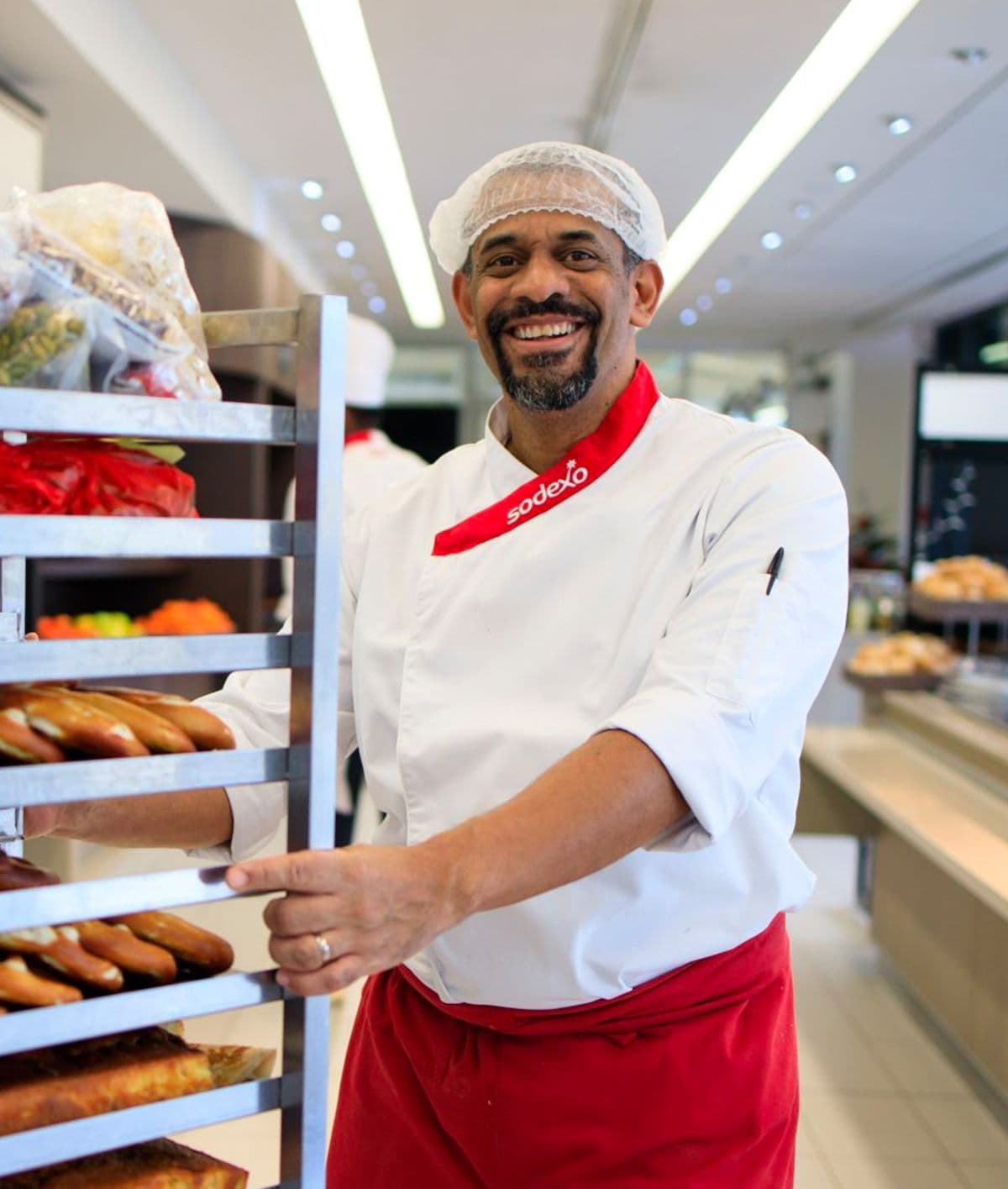Sarah Beldo |
Companies with a sizable frontline workforce face a number of challenges. Turnover tends to be high and engagement low, with studies estimating that 50% of frontline employees have considered quitting.
With numerous high-priority roles to fill, enabling skilled workers to move into those positions can be tricky–impacting organizations’ bottom line.
Sodexo, a global leader in Food and Facilities Management that serves 80 million customers across 27,000 sites, brought an innovative lens to addressing these challenges. They built a holistic learning program that spans the entire journey of their frontline employees globally—from their first day to their next career step within the company.

Their conviction was that incorporating learning into the employee experience would be crucial to increasing retention, improving satisfaction, and building necessary skills for the jobs of today and tomorrow.
Operations Academy was thoughtfully designed from the ground up to address the particular needs of Sodexo’s diverse global workforce. But employers across industries can learn from how they approached, built, and rolled out this ambitious initiative.
Lesson 1: Orient your program to deliver on your EVP
From a business perspective, the most pressing problem Sodexo needed to solve was to increase employee retention. To do this, it was crucial for the company to do everything in its power to make sure it was truly delivering on its employee value proposition (EVP).
As a purpose-driven company, Sodexo’s EVP promises prospective employees the opportunity to be part of something greater and have a real impact: to belong to a team, act with purpose, and thrive in their own way.
“We are in an extremely competitive talent market,” explained Nathalie Estellat, Group Learning and Development Chief Officer at Sodexo. “We attract workers by promising that they can make an impact, grow, and thrive."
"If we aren’t delivering the development opportunities people are looking for, they are not going to prosper in their roles—and they will leave for one of our competitors."
Nathalie Estellat, Group Learning and Development Chief Officer at Sodexo
The objective of Operations Academy was to gather a unique consistent training and career development framework and to ensure that each frontliner is well onboarded in their job and in the company. Previously, different locations took different approaches, which meant that employees’ experience of the company and their understanding of its mission and values could have been fragmented.
Continual improvement, which Sodexo calls “the spirit of progress,” is part of the company’s DNA—and is also the foundation for the entire program. The concept of always learning something new and progressing in your career journey is an attitude and behavior that infuses day-to-day work and life.
As a result, learning becomes a force multiplier: for individual employees, for teams, and for the business as a whole. Each individual adds to their skill set and becomes more effective in their job, more able to fill additional high-demand roles across the company, and more satisfied with their career path.
Lesson 2: Design for the employee’s entire journey
At many companies with frontline workers, onboarding is prioritized so employees can quickly get up to speed as quickly as possible. But after those early weeks, career path conversations, professional development, and internal mobility may fall by the wayside. And that’s when workers feel disengaged—and leave.
“We designed a holistic program so that we can deliver opportunities for people at all levels to progress in their work, elevate their expertise, and grow internally and benefit from mobility,” Nathalie said.
Sodexo wanted to buck that trend by building learning and development into every aspect of an employee’s journey, which they divided into three stages: onboarding, continuous development, and going further. During the first component, learners take in new information around health and safety, procedures, compliance, and company history.

Onboarding also goes beyond functional aspects to showcase the broader benefits of being part of the team, reinforcing the company's culture, values, and the pride of their colleagues from day one.
After that, learners will flow seamlessly into their day-to-day work, where they will have ongoing access to learning content based on their specific role (such as Food Academy), career pathways, and conversations about what career growth will look like for them.
Finally, the “going further” layer adds an extra component to support the learner’s dreams and goals: courses, certifications, referral programs.
“Successful onboarding is not a one-time event but an ongoing process. From increased productivity and lower turnover to enhanced customer satisfaction, investing in employee integration has many benefits.”
Nathalie Estellat, Sodexo
Lesson 3: Talk to employees—and design for their needs
A program will not be successful if employees don’t see the value in what they’re learning. Yet many education programs base their curriculum on top-down assumptions about what’s important, without validating these ideas with the end users: employees.
“The number one most important thing for creating a successful program is to understand what your learners want to learn. Speak to them first.”
Nathalie Estellat, Sodexo
Sodexo started by conducting a regional survey of both workers and their managers to understand needs and best practices. They asked the workers what they wanted to improve from or add to existing programs, and they asked managers what they thought was most important. They did this across all of their markets.

This early user input ensured that they were refreshing their existing offerings and designing a new program that would be engaging, relevant, and applicable in all of the locations where it would be rolled out.
And by incorporating an iterative approach to test an early version of Operations Academy with a subset of people, the team was able to incorporate early learnings quickly and make improvements before rolling it out to larger groups.
Lesson 4: When managers listen and are empathic , workers are engaged
So much of a frontline worker’s day-to-day satisfaction is influenced by their experiences working with peers and supervisors—and, of course, customers. Because managers are close to their teams on-site, Sodexo identified that managers were the most important group that could impact an employee’s desire to stay and grow their career at the company.
In addition to surveying managers in the early discovery stages of the project, Sodexo has invested in creating robust resources like videos, virtual trainings, one-pagers, and other training materials specifically aimed at helping managers infuse an employee’s journey with support and encouragement.
Regular check-ins with managers emphasize a culture of support and mentorship, ensuring that employees feel empowered to thrive in their roles. As part of the Onboarding Academy curriculum, managers meaningfully engage with their new employee at least four times throughout the newcomer’s first month. At the end of the first week, the questions they ask include: What did you learn? Where did you get stuck? How can I help?
By the final checkpoint, managers are asking newcomers: Where do you see your career going at Sodexo? For many employees, this is the first time in their working life that they’ve had a manager ask them about their career aspirations. By the end of the three-month onboarding period, Sodexo aims for its employees to envision a future within the company.
“When managers engage with their employees, they’re less likely to walk away. And if we reduce employee turnover, we’ll enhance service delivery.”
Julie Fox, Senior Training Manager at Sodexo
Building on early wins for future success
Delivering a comprehensive learning and development program for tens of thousands of frontline workers is no easy feat. The Sodexo team has taken a staged approach to roll-out, with steps of progress and continual improvement, which has allowed them to gather early insights about what’s working and what isn’t—and also to see encouraging results that will help build even more momentum as the program expands.
Since launching the onboarding phase of Operations Academy in 2023, 60% of pilot sites in the US report that they’ve decreased their regrettable turnover rate. And 72% of US employees who have gone through onboarding say they would recommend Sodexo as a good place to work based on their experience in the program.

These results show a lot of progress towards Sodexo’s main objectives of increasing employee retention and boosting engagement.
“We’ve integrated learning pathways into our onboarding process, which is positively impacting workers’ early experiences with Sodexo,” Nathalie explained.
“We’re already bringing clarity to what they need to do today. Next, we will show them the possibilities to advance their career internally in the future.”
Nathalie Estellat, Sodexo
5 must-haves for designing learning programs for a diverse workforce
_Sodexo’s Employee Experience Project Manager Alina Tilinc_ă shares the top considerations.
Different formats
People from different backgrounds have diverse learning styles and preferences: some may prefer visual aids, while others like hands-on experiences or auditory learning.
Multilingual resources and support
Language barriers can hinder effective communication and comprehension of training materials.
Culturally sensitive content
What’s acceptable in one culture may not be so in another—and this can impact how someone perceives and responds to training content. It's crucial to avoid unintentional biases or stereotypes.
Accessibility
This includes providing accommodations such as closed captions for videos, screen readers, and accessible formats for different learning needs.
Technology access and literacy training
Disparities in tech access and literacy can impact their ability to participate in online or technology-based learning initiatives.



